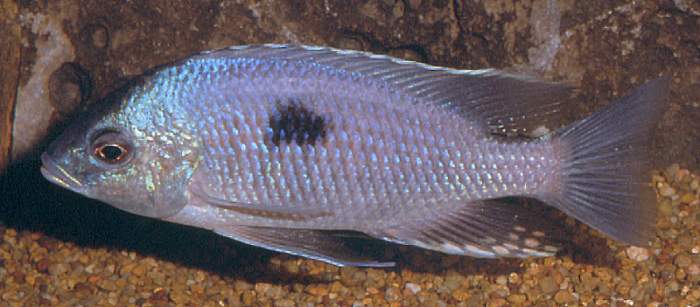

Copadichromis pleurostigma (above) is one of the over two dozen species currently classified in the "Utaka" assemblage. All of these are now placed in the probably non-monophyletic genus Copadichromis, and are shoaling, open-water haplochromine cichlids that generally feed on zooplankton. This adult male from the Tanzania shore of Lake Malawi was photographed in an aquarium by Mark P. Smith, who generously allowed me to use his photo here. (Read the publisher's blurb on Mark's new book, Lake Malawi Cichlids.)
Unlike all other Utaka except the nominal species C. trimaculatus, which I suspect may be a synonym, C. pleurostigma is apparently specialized to feed not on zooplankton, but on phytoplankton (Eccles & Trewavas, 1989; Konings, 1995c). Anatomical adaptations for this diet include a very long intestine and specialized pharyngeal dentition including many small, crowded teeth that are thought to function in rupturing the cell walls of the phytoplankton.
C. pleurostigma is one of the largest Utaka. In the Lake, it grows to a length of at least 165 mm (6½ inches) standard length (i.e., excluding the caudal fin) and 203 mm (8 inches) total length. Konings (1995c) provides the following remarks about its ecology and reproduction:
It is normally found over sand in the intermediate or sandy habitat. At Msuli Point mouthbrooding females have been observed (in November) releasing their fry among the small schools of other utaka juveniles that are usually found above nests of the kampango (Bagrus meridionalis). It thus appears they do not guard their offspring after release. Juveniles are bright yellow all over their bodies but lose the yellow colour on their flanks as the mature.
Like C. pleurostigmoides, C. pleurostigma also
has a melanic color pattern consisting of a large, black
suprapectoral spot and no
supra-anal spot.
The suprapectoral spot of C. pleurostigmoides is squarish and does not extend
above the upper part of the lateral line tubules, whereas that of C. pleurostigma
is longer than tall (horizontally elongate), and extends slightly above the
lateral line. C. pleurostigma has only about 17-18 gill rakers,
compared to 21 or more in C. pleurostigmoides.

| Last Update: 19 June 2001
Web Author: M. K. Oliver, Ph.D. Copyright © 1997-2021 by M. K. Oliver, Ph.D. - ALL RIGHTS RESERVED |